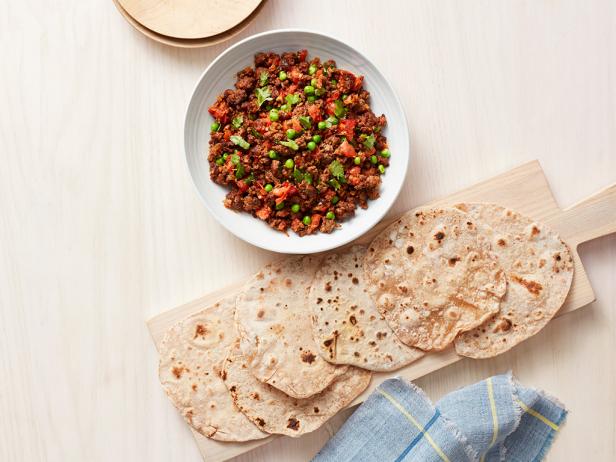“My girls jump up and down when they hear I’m making chapatis for dinner. They line up next to me and help me roll the dough. It connects me with my ancestors. It’s magical,” says Aarti.
| Level: | Intermediate |
| Total: | 1 hr 50 min |
| Active: | 1 hr 10 min |
| Yield: | 4 servings of kheema and 12 chapatis |
Ingredients
- 3 tablespoons canola oil
- 1 medium onion, finely diced
- 4 cloves garlic, minced
- 1 1-inch piece fresh ginger, peeled and minced
- 2 teaspoons ground coriander
- 1 teaspoon paprika
- 1/2 teaspoon garam masala
- 1/2 teaspoon ground cumin
- 1/2 teaspoon cayenne pepper (optional)
- 2 medium tomatoes, chopped
- 1 pound ground beef
- Kosher salt and freshly ground black pepper
- 1 cup shucked fresh English peas or 1/2 cup frozen peas, thawed
- 2 teaspoons malt vinegar or apple cider vinegar
- 1/4 cup chopped fresh cilantro, plus a few extra leaves for garnish
- Warm chapatis, for serving (recipe follows)
- 1 cup whole-wheat flour, plus more for dusting
- 1 cup all-purpose flour
- Big pinch of fine sea salt
- 1 cup water
- 1/4 cup olive oil, vegetable oil, melted butter or ghee
Instructions
- Heat the canola oil in a large skillet over medium-high heat. Add the onion and cook, stirring, until golden, about 4 minutes. Add the garlic and ginger and cook, stirring, until softened, 1 minute. Stir in the coriander, paprika, garam masala, cumin and cayenne and cook for another minute.
- Stir in the tomatoes until well mixed. Add the beef and cook, breaking it up with a wooden spoon, until the meat is no longer pink, about 6 minutes. Add 1 cup water and season with salt and black pepper. Add the peas, stir well and simmer, partially covered, until tender, about 10 minutes for fresh peas or 5 minutes for thawed frozen peas.
- Stir in the vinegar and chopped cilantro. Garnish with torn cilantro and serve with warm chapatis.
- Combine both flours and the salt in a large bowl. Slowly pour in the water, moving your other hand through the flour in circular motions, until it starts to come together (you may not need all the water). Then, either in the bowl or on your counter (which you might want to lightly flour to prevent sticking), knead the dough for about 10 minutes. The dough should be soft and pliable. Return the ball of dough to the bowl and rub the surface with a little oil to keep it from drying out. Cover with plastic wrap or a damp cloth and allow to rest about 30 minutes.
- Fill a shallow bowl with whole-wheat flour. Fill a small bowl with the oil or melted butter or ghee and put a spoon in it. Line a plate or baking sheet with paper towels for the finished breads. Heat a cast-iron skillet over medium-high heat. Meanwhile, on a lightly floured surface, work the ball of dough into a 12- to 14-inch-long log. Cut into 12 equal pieces by cutting it in half, and then in half again; cut each of the quarters into 3 equal pieces. Return to the bowl and cover with a damp towel to prevent the dough from drying out.
- Roll the chapatis: Roll a piece of dough between your palms to form a ball, and then flatten with your palm. Dunk this puck in the bowl of whole-wheat flour, and then start rolling it out with a rolling pin, turning a quarter turn after each roll, until it’s about 6 inches wide with an even thickness. After some practice you’ll be able to roll the chapati and rotate it without picking it up; I do this by weighing down a little on my right hand and pushing the chapati around that way. Test the skillet by sprinkling a little flour on it; if it turns brown immediately, it’s ready.
- Flap the chapati between your hands to remove any excess flour, then slap the chapati onto the skillet. It should start darkening almost immediately. When small bubbles start to form, 1 to 2 minutes, spread a little oil over the surface of the chapati, then flip. It should start to puff up. Spoon a little oil over this side too, and when it’s puffed up a little more, about 1 minute more, flip. Press down on the edges of the chapati with your spatula or (if you’re brave!) with a dry rag. This will seal the edges and encourage the entire chapati to puff up. If you spot any holes, press down on those too so the air doesn’t escape. Allowing the air to stay inside the whole chapati makes it flaky and light. Don’t fret if your first few don’t puff up; it takes practice! They will still taste delicious.
- Remove the chapati to the paper towels. Repeat with the remaining dough, taking care to wipe any excess flour or oil from your pan occasionally and adjusting the heat as needed. Serve the chapatis warm.
Nutrition Facts
| Serving Size | 1 of 4 servings |
| Calories | 782 |
| Total Fat | 48 g |
| Saturated Fat | 12 g |
| Carbohydrates | 59 g |
| Dietary Fiber | 8 g |
| Sugar | 5 g |
| Protein | 30 g |
| Cholesterol | 81 mg |
| Sodium | 916 mg |
